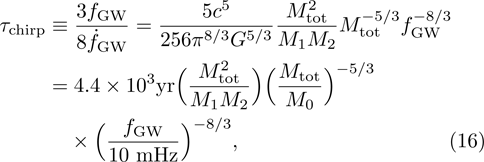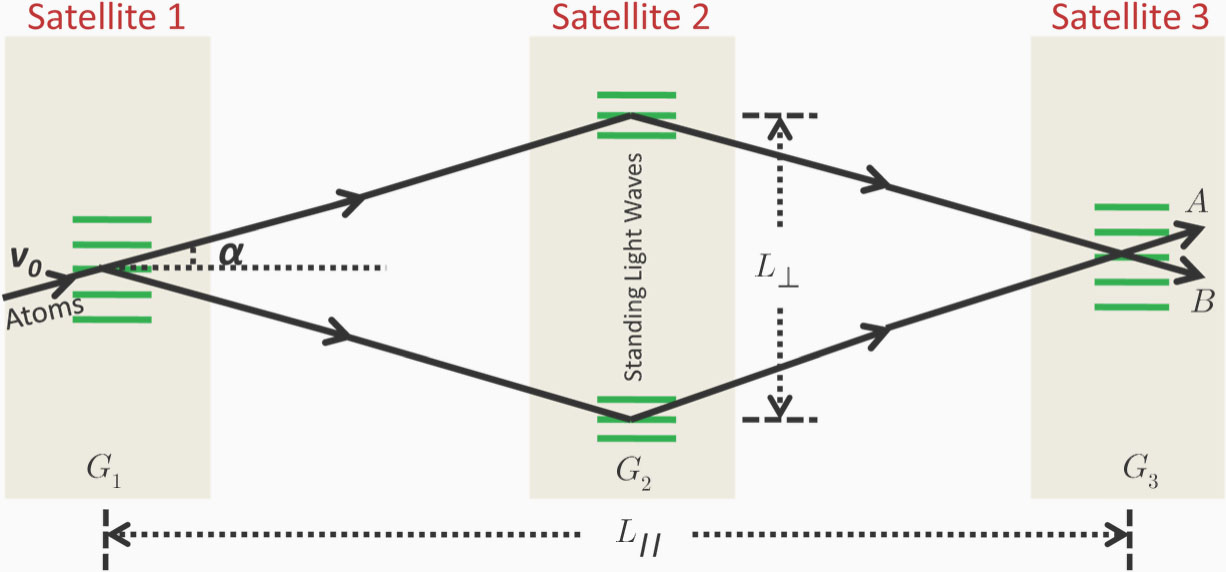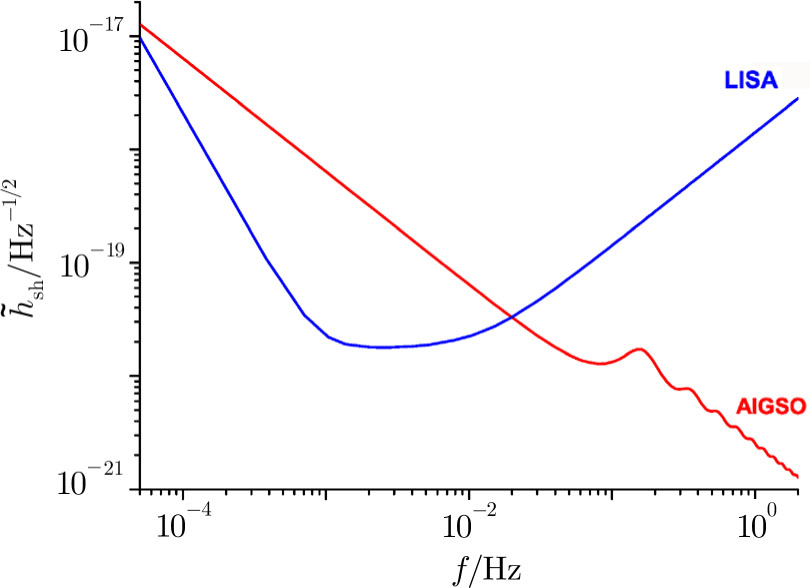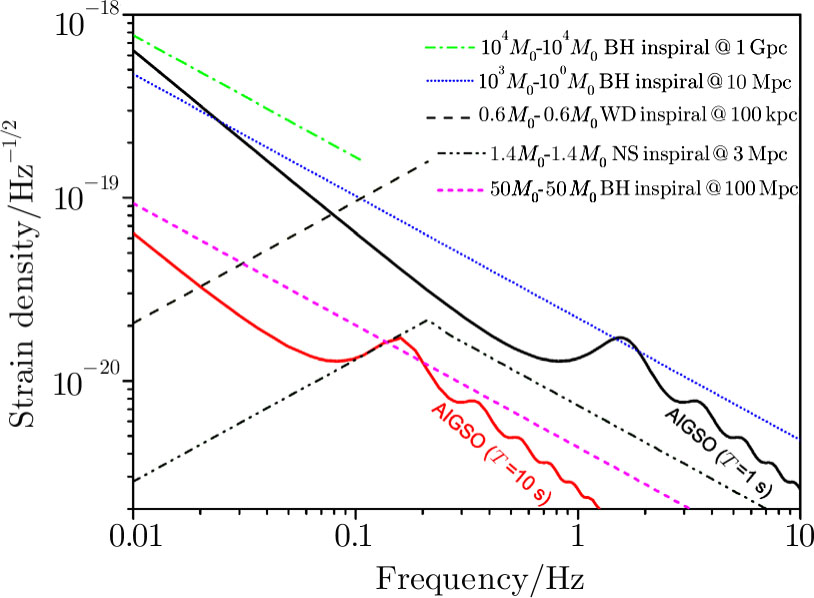† Corresponding author. E-mail:
We propose a space-borne gravitational-wave detection scheme, called atom interferometric gravitational-wave space observatory (AIGSO). It is motivated by the progress in the atomic matter-wave interferometry, which solely utilizes the standing light waves to split, deflect and recombine the atomic beam. Our scheme consists of three drag-free satellites orbiting the Earth. The phase shift of AIGSO is dominated by the Sagnac effect of gravitational-waves, which is proportional to the area enclosed by the atom interferometer, the frequency and amplitude of gravitational-waves. The scheme has a strain sensitivity 
An important prediction of Einstein’s theory of general relativity is the existence of gravitational waves (GWs). The indirect evidence comes from the timing measurements of the binary pulsar, PSR 1913+16.[1] Since 1970s, a lot of ground-based GW detectors have been built to detect GWs directly.[2] After decades of efforts, the LIGO Scientific Collaboration and Virgo Collaboration announced the first two observations of GWs in 2016,[3–4] and three more observations in 2017,[5–7] which opened a new era in the study of the universe. However, due to the seismic and Newtonian noise on the Earth, the ground-based laser interferometric detectors, such as LIGO, could only detect GWs with frequencies above 10 Hz. To search for GWs in the lower frequency band, several space-based laser interferometric detection schemes (such as LISA,[8] TianQin,[9] DECIGO,[10] BBO,[11] and AMIGO[12]) have been proposed. However, to reach high sensitivity and wide operating frequency, these space-based laser interferometric GW detection proposals inevitably have to be large in size, and be expensive to build. Then, it is of great value to investigate alternative detection schemes that can have comparable sensitivity, be smaller in size, and be less expensive.
After more than twenty years of development, atom interferometers (AIs) have reached very high sensitivity.[13] In fact, AIs have already been used in a large range of precision measurement experiments such as the measurements of the fine structure constant α[14] and the Newtonian gravitational constant G,[15] which have already been adopted by the 2014 CODATA.[16] The AI was also used to give a 10−8-level test of the weak equivalence principle (WEP) in Ref. [17]. Motivated by these impressive achievements, people began to work on the possibility of using AIs to detect GWs. Several terrestrial atom interferometric GW detection schemes were proposed in Refs. [18–22] Moreover, spaced-based atom interferometric GW detection schemes were put forward in Refs. [18, 21, 23–24]. Compared to the space-borne laser interferometric GW detectors, the atoms are used as inertial test masses, instead of mirrors. Thus, to reach comparable sensitivity to LISA, these spaced-based atom interferometric GW detectors need to be of similar size too.
In this paper, we put forward a different proposal, called the atom interferometric gravitational-wave space observatory (AIGSO), which is an extension of our previous terrestrial GW detection scheme in Ref. [22]. Our AIGSO consists of three drag-free satellites, with a baseline length of 10 km, and a width of 1 m. With standing light waves, we can split, reflect and recombine a variety of atomic beams. What is more, the atoms always remain in the same internal state so that the atomic phase is not sensitive to external fields and fluctuations in laser beams. Our calculation shows that the phase shift of AIGSO is dominated by the Sagnac effect of GWs. In other words, our AIGSO is essentially an atomic Sagnac interferometric GW detector. Thus, it can be regarded as a matter-wave analogue of the laser Sagnac interferometric GW detector, which was considered as an attractive candidate for third-generation laser interferometric GW detectors in Refs. [25–26].
The remarking features of our AIGSO are the following. Compared to other spaced-based atom interferometric GW detectors in Refs. [21, 23–24], our scheme is a genuine use of atomic matter-waves, not just used as inertial test masses instead. The size of our scheme is much smaller, and the atomic flux intensity can be much higher. Compared to the space-borne laser interferometric GW detectors, our scheme is much smaller in size, and is complementary in the GW frequency range. Our AIGSO is faster, where the integration time is reduced from one year to several days. Thus, in the same observation time, our scheme can detect GWs from more weaker sources.
The rest of the paper is organized as follows. In Sec.
The schematic diagram of our proposed AIGSO is depicted in Fig. 

The atomic beam is first produced from a supersonic source, with initial velocity v0. It should be well collimated so that the distribution of the transverse velocity of atoms can meet the requirement of GW detection. Then, the atomic beam is equally split into two beams of angle 


The size of our AIGSO is basically constrained by the environment outside the satellites since the atomic beams propagate between the satellites. The outside environment is full of background gases and solar photons. Collisions of atoms with them will destroy the coherence of atomic beams. According to the estimation in Ref. [21], a space-borne atom interferometer, with interrogation time 





In this subsection, we will calculate the phase shift caused by the incoming GWs, which is very similar to the one for our terrestrial GW detection proposal in Ref. [22]. For completeness, we review the calculation as follows.
The interferometric area is supposed to be the xy plane, and the GWs propagate in the z direction. In the rigid frame, the metric for the GWs can be written as









The geodesic equations for particles confined in the z = 0 plane are

The Lagrangian for a non-relativistic atom is

For a given trajectory, the phase at the final point can be calculated as


Before the incoming of GWs, atoms move along the classical trajectories,





Solving the geodesic equations for atoms, we can calculate the phase for each arm,





Since 

Note that 
The feature of our result is that it contains two terms from two different contributions, which is quite similar to the result in Ref. [20]. Denote the first term in Eq. (







In the frequency range 










Shot noise is the fundamental limit on the detection sensitivity of any interferometric GW detector. To compare the sensitivity of different GW detectors, people normally introduce the power spectral density for the shot-noise-limited sensitivity, 




This formula can be further simplified. Since the atomic beam is split by the standing light waves, the angle 





We can see that 


To draw the sensitivity curve for our scheme, we have to specify these design parameters, which are supposed to be based on either current available technologies or future improvements. As discussed before, the size of AIGSO has been proposed to be 


To yield a good sensitivity in our scheme, the supersonic source of the atomic beam should have high intensity. Technologies of producing high intensity supersonic sources have been well developed.[27] For example, Argon beams, with intensity 





With these proposed scheme parameters, the corresponding sensitivity curve for AIGSO is drawn in Fig.
In the frequency band of AIGSO, the major sources of GWs are compact binaries, which consist of white dwarfs (WDs), neutron stars (NSs), or black holes (BHs). They emit strong GW radiations in the high frequency band at the late stage of their evolution.
The GW radiation from the evolution of compact binaries can be well calculated in the quadrupole approximation.[31–32] The GW strain amplitude 






For the purpose of GW detection, we also have to consider the time dependence of both the strain amplitude and the frequency. According to Ref. [31], the time rate of change in the radius is

Then, one can get

Here, one can introduce the inspiral timescale, which characterizes the remaining lifetime of a binary before merger

For a given GW source of strain amplitude 





Assume that the observation time 





In Fig. 





Through this preliminary study, we have described our atomic matter-wave Sagnac interferometric GW detection scheme, AIGSO, consisting of three drag-free satellites. Unlike other spaced-based atom interferometric GW detection proposals, our scheme is a genuine use of atomic matter-wave interferometry, instead of using just as inertial test masses. Compared to the space-borne laser interferometric GW detectors, our AIGSO is about 5 orders of magnitude smaller in size, which hopefully means the cut-down in technological requirements and in expense. Just like the laser Sagnac interferometer, which has been considered as an attractive candidate for the third-generation terrestrial GW detectors, our scheme is conceptually new, and can be a promising candidate for the future space-based GW detector. Of course, before becoming a real project, we need a thorough analysis of our AIGSO, which will be done in our future work.
Our AIGSO has a strain sensitivity 





| [1] | |
| [2] | |
| [3] | |
| [4] | |
| [5] | |
| [6] | |
| [7] | |
| [8] | |
| [9] | |
| [10] | |
| [11] | |
| [12] | |
| [13] | |
| [14] | |
| [15] | |
| [16] | |
| [17] | |
| [18] | |
| [19] | |
| [20] | |
| [21] | |
| [22] | |
| [23] | |
| [24] | |
| [25] | |
| [26] | |
| [27] | |
| [28] | |
| [29] | |
| [30] | |
| [31] | |
| [32] | |
| [33] | |
| [34] | |
| [35] | |
| [36] |




